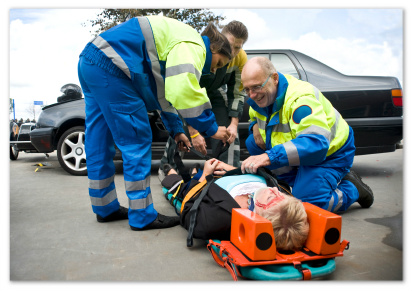
While you may well be excited to start your paramedic course, it's essential to recognize exactly what you're undertaking, in addition to how to carry out doing it.
For instance, do you realize how much money paramedic classes cost? Do you know what the minimum age qualifications are for every school that you're interested in applying to?
Are you mindful that some academic institutions necessitate written referrals and in-person conversations? Or that many schools or ambulance services may not be interested in your services if you have been charged or declared guilty of an unlawful act?
There are a whole lot of small matters to be familiar with when it involves understanding the best ways to become a paramedic. So let's review them here.
To begin, let's begin with just one important thing to know: As of January 1st, 2013, all students who are interested in obtaining national certification from the NREMT are going to now be called for to have graduated from an accredited paramedic program.
To discover accredited programs, make sure to visit CAAHEP.org.
With that said, as far as each school is concerned, there are a number of prerequisites students must fulfill before having the chance to be genuinely considered for any training program. And although each paramedic program is unique, the overall prerequisites are as follows:
You need to be 18 years or older. You additionally need to have graduated from high school or earned your GED.
You'll need a legitimate driver's license.
You must already have EMT certification. That does not mean, necessarily, that you must have Emergency Medical Technician work experience (though many paramedic programs encourage students to get the job done as an EMT first before taking paramedic classes).
You need to get CPR certification. You'll also possibly need to have already taken an anatomy and physiology course. If you haven't accomplished this, kindly call the school you're interested in applying to. It's fairly possible that they provide an anatomy and physiology course as part of the overall paramedic program. A few programs may also ask their prospective medics to have an Advanced Cardiac Life Support certification, too.
You will also need to be able to prove that you're a healthy individual. That means you'll need to have had a physical exam, as well as provide verification of multiple immunizations. You will need to be vaccinated for illnesses like Tuberculosis, Hepatitis and Measles, Mumps and Rubella to name a few.
You'll additionally need to pay for an application fee to each program you apply to, which can range in cost based on where you apply.
Now that you have a better awareness of how the application process for becoming a paramedic student works, you may well be questioning tuition cost.
The truth is that the cost of paramedic class varies greatly. With that said, you can count on paying anywhere between $ 1,000 and $ 10,000 for a paramedic program.
Course length can be different too, as there are a vast selection of programs colleges offer. Some programs may give students weekday classes. Some other programs may provide more overall flexibility with a Saturday and Sunday class.
Some schools even supply Internet paramedic training. What that usually means is that a Hybrid Paramedic Program is being provided to pupils, allowing them the chance to learn both in the school room as well as over the Internet. This is obviously extremely advantageous if you possess a day job or you are the prime caretaker in your family.
With that said, paramedic courses can take anything from 6 months to about two years to complete. Depending on the program, you may graduate the training class with either a certification or an actual degree.
It's definitely worth briefly pointing out what occurs once you've in fact finished a paramedic training program. Following graduation, you'll very likely want to find employment, but you need to do a couple of things first.
One, it is highly recommended that you fill out an application for national certification with the NREMT. To do so, you need to pass the NREMT examinations, which is both a computer adaptive exam and a skills examination.
Nevertheless, passing the national registry paramedic exams does not mean that you're qualified to work as an EMT-P on the state level. It's just a national acknowledgment.
To be a candidate to work as a paramedic in your state, you'll have to apply for state licensure. This might often be as straightforward as filling out some paperwork and forwarding it to your state's EMS agency, or a lot more involved, necessitating that you to successfully pass a state test.
To learn more about paramedic training, be sure to visit Paramedic Training Spot!
For instance, do you realize how much money paramedic classes cost? Do you know what the minimum age qualifications are for every school that you're interested in applying to?
Are you mindful that some academic institutions necessitate written referrals and in-person conversations? Or that many schools or ambulance services may not be interested in your services if you have been charged or declared guilty of an unlawful act?
There are a whole lot of small matters to be familiar with when it involves understanding the best ways to become a paramedic. So let's review them here.
To begin, let's begin with just one important thing to know: As of January 1st, 2013, all students who are interested in obtaining national certification from the NREMT are going to now be called for to have graduated from an accredited paramedic program.
To discover accredited programs, make sure to visit CAAHEP.org.
With that said, as far as each school is concerned, there are a number of prerequisites students must fulfill before having the chance to be genuinely considered for any training program. And although each paramedic program is unique, the overall prerequisites are as follows:
You need to be 18 years or older. You additionally need to have graduated from high school or earned your GED.
You'll need a legitimate driver's license.
You must already have EMT certification. That does not mean, necessarily, that you must have Emergency Medical Technician work experience (though many paramedic programs encourage students to get the job done as an EMT first before taking paramedic classes).
You need to get CPR certification. You'll also possibly need to have already taken an anatomy and physiology course. If you haven't accomplished this, kindly call the school you're interested in applying to. It's fairly possible that they provide an anatomy and physiology course as part of the overall paramedic program. A few programs may also ask their prospective medics to have an Advanced Cardiac Life Support certification, too.
You will also need to be able to prove that you're a healthy individual. That means you'll need to have had a physical exam, as well as provide verification of multiple immunizations. You will need to be vaccinated for illnesses like Tuberculosis, Hepatitis and Measles, Mumps and Rubella to name a few.
You'll additionally need to pay for an application fee to each program you apply to, which can range in cost based on where you apply.
Now that you have a better awareness of how the application process for becoming a paramedic student works, you may well be questioning tuition cost.
The truth is that the cost of paramedic class varies greatly. With that said, you can count on paying anywhere between $ 1,000 and $ 10,000 for a paramedic program.
Course length can be different too, as there are a vast selection of programs colleges offer. Some programs may give students weekday classes. Some other programs may provide more overall flexibility with a Saturday and Sunday class.
Some schools even supply Internet paramedic training. What that usually means is that a Hybrid Paramedic Program is being provided to pupils, allowing them the chance to learn both in the school room as well as over the Internet. This is obviously extremely advantageous if you possess a day job or you are the prime caretaker in your family.
With that said, paramedic courses can take anything from 6 months to about two years to complete. Depending on the program, you may graduate the training class with either a certification or an actual degree.
It's definitely worth briefly pointing out what occurs once you've in fact finished a paramedic training program. Following graduation, you'll very likely want to find employment, but you need to do a couple of things first.
One, it is highly recommended that you fill out an application for national certification with the NREMT. To do so, you need to pass the NREMT examinations, which is both a computer adaptive exam and a skills examination.
Nevertheless, passing the national registry paramedic exams does not mean that you're qualified to work as an EMT-P on the state level. It's just a national acknowledgment.
To be a candidate to work as a paramedic in your state, you'll have to apply for state licensure. This might often be as straightforward as filling out some paperwork and forwarding it to your state's EMS agency, or a lot more involved, necessitating that you to successfully pass a state test.
To learn more about paramedic training, be sure to visit Paramedic Training Spot!

 RSS Feed
RSS Feed